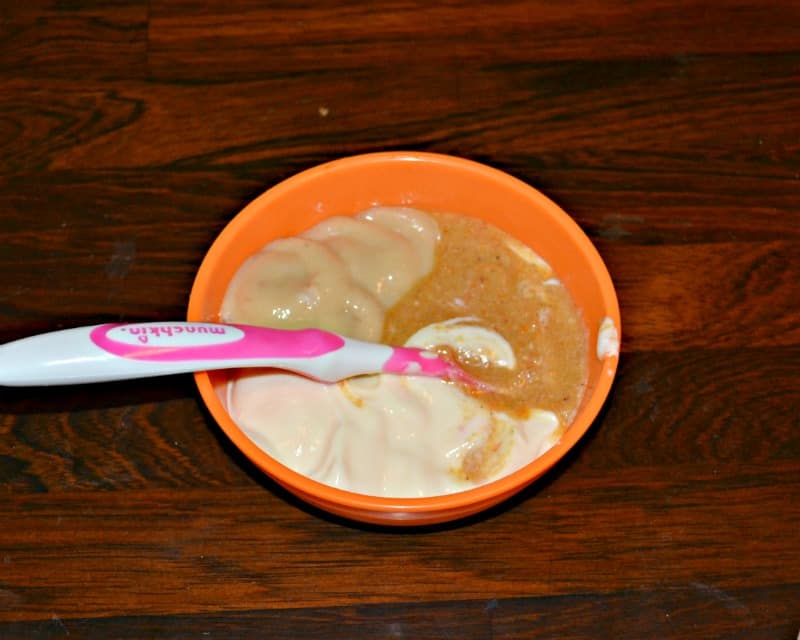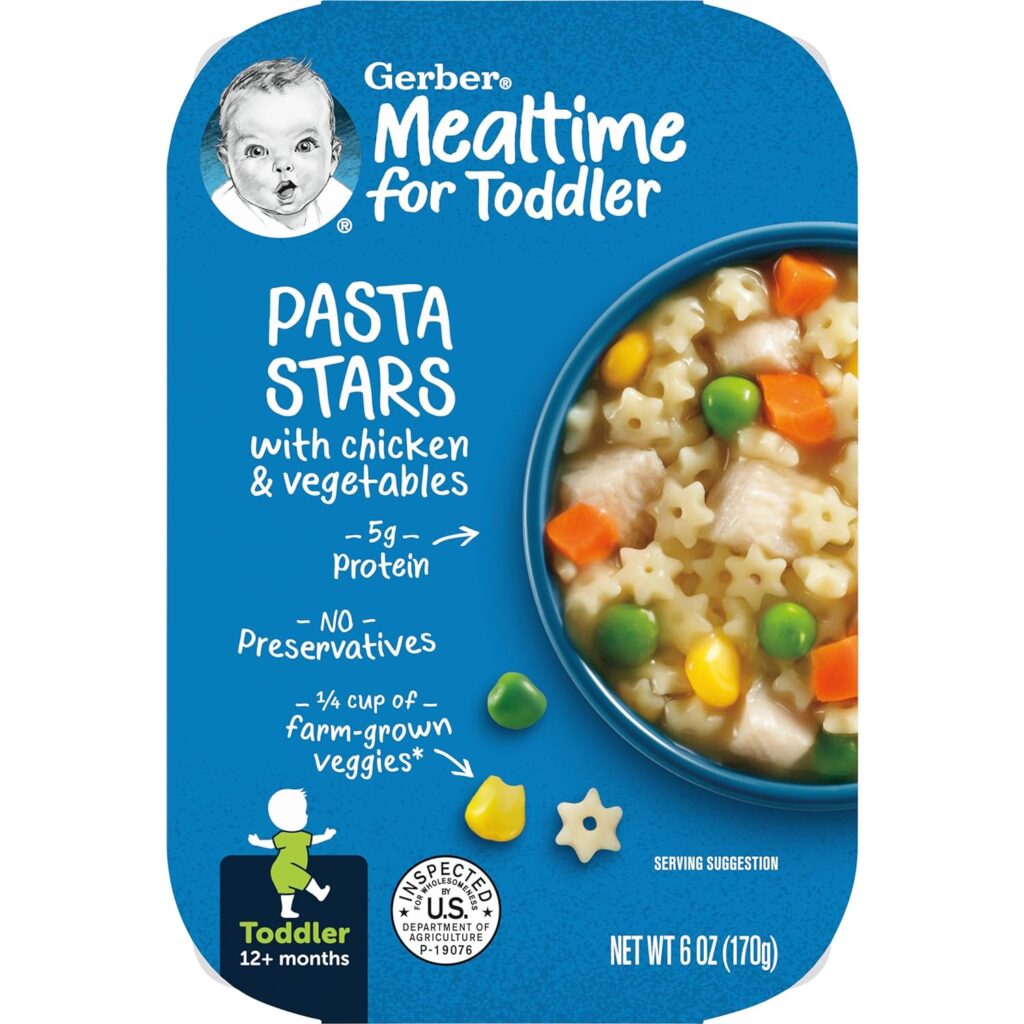Chicken and rice baby food is a nutritious meal option for infants, offering a blend of protein and carbohydrates. It’s ideal for transitioning babies to solid foods.
Chicken and rice baby food combines the essential proteins from chicken with the easily digestible carbohydrates from rice, making it a perfect choice for a baby’s developing digestive system. This combination can help introduce new textures and flavors to your child, aiding in their overall growth and food acceptance.
Homemade versions allow for control over ingredients, ensuring the meal is free from added salts, sugars, and preservatives. Commercial preparations are also available for convenience, often fortified with additional vitamins and minerals necessary for a baby’s health. Both homemade and store-bought options provide a balanced meal for babies ready to explore more solid foods.

Nutritional Benefits
As your baby grows, proper nutrition is key. Chicken and rice baby food is a powerhouse of essential nutrients. It supports growth and development. Let’s explore the healthful components this meal offers.
Protein From Chicken
Chicken is a high-quality protein source. It’s crucial for building muscles and repairing tissues. In chicken and rice baby food, the protein aids your baby’s growth. It also strengthens their immune system. Here’s how chicken benefits your little one:
- Builds muscle: Protein is the building block of muscles.
- Boosts immunity: Antibodies that fight disease need protein.
- Heals the body: Protein helps in repairing cells and tissues.
Carbohydrates From Rice
Rice in chicken and rice baby food provides energy. Carbohydrates are the main energy source for babies. They fuel the brain and body throughout the day. Rice has benefits like:
| Benefit | Description |
|---|---|
| Energy production: | Carbs are converted into glucose, the body’s energy. |
| Balanced digestion: | Rice has fiber which helps in healthy digestion. |
| Brain fuel: | Glucose from carbs powers your baby’s brain. |
Together, protein from chicken and carbs from rice make a complete meal. This meal supports your baby’s overall health and well-being.

Credit: www.hezzi-dsbooksandcooks.com
Preparing Chicken And Rice Baby Food
Introducing solids to your baby is a major milestone. Chicken and rice baby food is a nutritious option that’s easy to prepare. It’s a fantastic way to give your little one a taste of real food. Let’s dive into how to make this wholesome meal.
Ingredients Needed
Before starting, gather the following ingredients:
- 1/4 cup of brown rice
- 1 cup of water
- 100 grams of boneless, skinless chicken breast
- Optional: a pinch of mild herbs or spices for flavor
Cooking Instructions
Follow these steps to create a delicious meal for your baby:
- Rinse the rice under cold water to remove starch.
- Cook the rice in water until tender. This usually takes about 30 minutes.
- Chop the chicken into small pieces. Ensure no bones are present.
- Steam or boil the chicken until it’s fully cooked, usually 15-20 minutes.
- Blend the chicken and rice together. Add water or your baby’s usual milk to get the right consistency.
- Test the temperature before serving to make sure it’s safe for your baby.
Chicken and rice baby food is now ready to serve! You can store leftovers in the fridge for up to 48 hours.
Age Appropriateness
Introducing chicken and rice baby food to your little one is a milestone. The right age to begin matters. Babies typically start on solids around 4 to 6 months. Always consult your pediatrician first. They will guide you based on your baby’s development and readiness.
Introduction Time
Start with a single-ingredient puree. It lets you monitor for any allergic reactions. Chicken and rice are excellent first foods. They are rich in protein and carbohydrates. Both provide the energy babies need. Begin with chicken and rice separately. Later, combine them for a tasty meal.

Texture Variation By Age
- 4 to 6 months: Offer a very thin puree. It should be almost liquid. It’s easier for babies to swallow.
- 7 to 9 months: Move to thicker purees. Mix in soft rice. It encourages chewing skills.
- 10 to 12 months: Introduce soft, bite-sized pieces. Babies can practice picking up food. They learn to manage more solid textures.
Remember, every child is different. Progress at a pace suited to your baby’s abilities. Always ensure the food is soft enough to prevent choking.
Variations
Exploring the world of chicken and rice baby food opens a door to creative variations. These variations not only introduce new flavors to your baby’s palate but also pack in additional nutrients. Let’s dive into how we can enrich this classic meal with vegetables and fruits.
Adding Vegetables
Vegetables are a powerhouse of vitamins and minerals. Blending veggies into chicken and rice baby food creates a nutritious feast. Here are some options:
- Carrots: They add sweetness and vitamin A.
- Peas: A good source of iron and fiber.
- Broccoli: High in vitamin C and antioxidants.
Steam and puree these vegetables before mixing with chicken and rice to ensure a smooth consistency suitable for your baby.
Incorporating Fruits
Fruits can be a delightful twist to the savory chicken and rice baby food. They bring natural sweetness and a boost of vitamins. Consider these fruit additions:
- Apples: Rich in fiber and a hint of sweetness.
- Bananas: Offer potassium and a creamy texture.
- Pears: Gentle on the stomach and mildly sweet.
Cook and mash the fruits before incorporating them into the meal. This ensures an easy-to-eat texture for your little one.
Storage
Storing chicken and rice baby food properly is key to keeping it fresh and safe. Here’s how you can store it in the fridge or freezer.
Refrigeration Tips
Follow these simple steps to keep chicken and rice baby food fresh in your refrigerator:
- Use an airtight container to avoid odors.
- Label containers with the date of storage.
- Keep at the back of the fridge where it’s coldest.
- Use within 48 hours for best quality.
Freezing Guidelines
Freezing chicken and rice baby food extends its shelf life. Here’s how to freeze it properly:
- Place the food in small portions.
- Use ice cube trays or small freezer bags.
- Label each portion with the freezing date.
- Thaw in the refrigerator overnight when needed.
- Once thawed, do not refreeze.
| Storage Method | Duration | Tips |
|---|---|---|
| Refrigeration | Up to 48 hours | Store in back, use airtight containers. |
| Freezing | Up to 1 month | Use small portions, label with dates. |
Feeding Tips
Introducing chicken and rice baby food to your little one can be a big step. This meal is a classic choice for parents. It’s full of nutrients and easy to digest. Let’s dive into some essential feeding tips to make mealtime smooth and enjoyable.
Serving Size
It’s important to get the portion right for your baby. Start with small amounts. A good beginning is one or two teaspoons of chicken and rice baby food. Watch your baby’s hunger cues. Offer more if they seem interested and stop if they turn away. Remember, each child’s appetite is different.
Transitioning To Solid Foods
Moving to solids is a big milestone. Begin with pureed chicken and rice baby food. It’s gentle on tiny tummies. Mix it with breastmilk or formula to make it familiar. Gradually thicken the texture as your baby gets used to eating. Always sit your baby upright during feeding and never rush the process.
- Start with a smooth puree.
- Combine with breastmilk or formula.
- Thicken texture over time.
- Keep baby upright while eating.
- Go at your baby’s pace.
Common Concerns
Introducing new foods to your baby’s diet is a milestone. “Chicken and rice baby food” is a nutritious option. Parents often have concerns. Let’s address some common ones.
Allergy Risks
Chicken and rice are low-allergy foods. Chicken is a great protein source. Rice is gentle on tummies. Yet, allergies can still happen. Symptoms include hives, vomiting, or trouble breathing. Always watch your baby eat new foods. Talk to a doctor if you notice any reactions.
Digestive Issues
Chicken and rice baby food is usually easy to digest. But, some babies might have trouble. Signs of digestive issues include gas, bloating, or constipation. Start with small amounts. This helps you see how your baby’s system handles the food. Keep a food diary. Note any changes in digestion or stool patterns.
| Quick Tips for Introducing Chicken and Rice Baby Food | |
| Tip | Reason |
|---|---|
| Start with rice. | It’s gentle on the stomach. |
| Add chicken gradually. | Monitor for any allergic reactions. |
| Keep portions small. | Helps identify digestive issues. |
- Introduce one food at a time.
- Wait 3-5 days before adding a new food.
- Observe your baby closely.
Chicken and rice baby food is a great choice. It’s rich in nutrients. It’s gentle on the stomach. Remember to introduce it slowly. This way, you can spot any issues early.

Safety Measures
Introducing chicken and rice baby food to your little one is exciting. It’s crucial to focus on safety measures to ensure your baby enjoys their meal without any risks. Let’s discuss essential safety tips.
Food Temperature Checks
Always check the temperature of chicken and rice baby food before feeding. Here’s how to do it:
- Stir the food well to even out the temperature.
- Test a small amount on the inside of your wrist. It should feel warm, not hot.
Using a food thermometer can help. Ensure it reads 98.6°F (37°C) – perfect for your baby.
Avoiding Choking Hazards
Preventing choking is vital for safe eating. Follow these steps:
- Ensure the food is smooth and without lumps.
- Cut down any larger pieces to make swallowing easier.
Always watch your baby while they eat. Keep them upright during feeding.
Taste Testing
Welcome to the delightful world of taste testing with chicken and rice baby food. As your little one embarks on their culinary journey, it’s essential to introduce new flavors with care.
Introducing Flavors Slowly
Starting with chicken and rice baby food is perfect for your baby’s palate. This classic combination is mild yet tasty. Remember to introduce chicken and rice separately at first. This way, you can ensure your baby enjoys each flavor on its own.
- Day 1-3: Offer plain rice purée.
- Day 4-6: Introduce pure chicken taste.
- Day 7: Mix them to create a familiar yet new experience.
Observing Reactions
Keep an eye on your baby’s expressions and body language. Positive signs include smiles and reaching for more. Negative reactions can be fussiness or turning away.
| Reaction | What it means | Action to take |
|---|---|---|
| Smiles | Baby loves it! | Continue to offer chicken and rice. |
| Reaching for more | They want another bite. | Give another spoonful of food. |
| Fussiness | Not enjoying the taste. | Try again tomorrow. |
| Turning away | They may be full or dislike it. | Do not force it; wait for the next meal. |
By introducing flavors slowly and observing reactions, your baby will soon love chicken and rice baby food. It sets the stage for a lifetime of healthy eating habits.
Benefits Of Homemade Baby Food
Creating homemade baby food like chicken and rice offers many advantages. Parents gain peace of mind knowing exactly what goes into their baby’s meal. In this blog post, we’ll explore the key benefits of whipping up your own chicken and rice baby food from scratch.
Control Over Ingredients
Homemade baby food shines in its ability to give parents complete control over ingredients. You decide what your baby eats and avoid unwanted additives. With chicken and rice baby food made at home, you ensure that your baby gets:
- Fresh, wholesome ingredients without preservatives
- Perfectly balanced nutrition tailored to your baby’s needs
- An introduction to natural flavors and textures
Cost-effectiveness
Preparing chicken and rice baby food at home is also cost-effective. Buying ingredients in bulk and cooking in batches can lead to significant savings. Here’s how homemade baby food can be gentle on your wallet:
| Store-Bought Baby Food | Homemade Baby Food |
|---|---|
| Often more expensive per serving | Lower cost per serving |
| Additional cost for packaging | No extra packaging costs |
| Price includes marketing and distribution | Only the cost of raw ingredients |
By choosing to make chicken and rice baby food at home, you save money and offer the best to your little one.
Comparison With Commercial Baby Food
Parents often wonder how homemade chicken and rice baby food stacks up against store-bought options. This section delves into the differences between the two, considering their nutritional value and sensory appeal to your little one.
Nutritional Value
Homemade chicken and rice baby food often boasts a superior nutritional profile. Let’s break it down:
- Fresh Ingredients: You control the quality of the chicken and rice, ensuring they’re free from preservatives.
- No Additives: Commercial foods may contain additives; homemade versions do not.
- Customizable: Tailor the meal to your baby’s nutritional needs by adding vegetables or iron-fortified rice.
Compared to commercial foods, homemade meals often provide more essential nutrients, like protein and vitamins.
Taste And Texture
When it comes to chicken and rice baby food, taste and texture are key:
| Aspect | Homemade | Commercial |
|---|---|---|
| Taste | Richer, as it’s made with fresh ingredients. | Often blander due to mass production. |
| Texture | Varied textures are possible by adjusting the blend. | Consistently smooth, which may not challenge your baby’s palate. |
Homemade baby food typically offers a more homemade taste. Babies learn to love real food flavors early on. Commercial options can seem less appealing in comparison.

Cultural Perspectives
Chicken and rice baby food is more than just a simple dish. It’s a canvas reflecting diverse cultural customs and parental care. Each culture imparts a unique twist on this comforting staple, showcasing a rich tapestry of global practices.
Traditional Practices
Across generations, traditional practices have shaped the way we introduce solids to infants. Chicken and rice baby food often serves as an ideal starting point. It’s gentle on the stomach and easy to digest.
- Rich in protein and carbohydrates, making it a balanced meal for growth.
- Prepared with love and care in many households, following age-old recipes.
- Often includes mild spices or herbs in some cultures, introducing babies to family flavors.
Global Variations
Chicken and rice baby food takes on many delicious forms around the world. Each country has its own version, suited to local tastes and dietary needs.
| Country | Variation | Unique Ingredient |
|---|---|---|
| Mexico | Arroz con Pollo | Cumin |
| India | Khichdi | Turmeric |
| Italy | Risotto | Parmesan |
The global variations are not just tasty, but also nutritious. They introduce infants to a world of flavors while ensuring they get essential nutrients.
Expert Opinions
When it comes to feeding babies, parents often seek the advice of experts. Chicken and rice baby food is a popular choice, and understanding what the experts have to say can help you make informed decisions. Let’s delve into pediatrician recommendations and nutritionist insights.
Pediatrician Recommendations
Pediatricians stress the importance of protein and iron in a baby’s diet. Chicken is a great source of both. It’s easily digestible for little tummies. Most doctors suggest introducing chicken and rice baby food around six months. Always start with small portions. Look for signs of allergies. Pediatricians also recommend organic options to reduce exposure to hormones and pesticides.
- Introduce at six months
- Start with small portions
- Watch for allergies
- Choose organic when possible
Nutritionist Insights
Nutritionists emphasize the balance of nutrients. Chicken and rice baby food can be a balanced meal. It combines protein, carbs, and fats. Rice offers energy for active babies. Chicken provides the building blocks for growth. Nutritionists also suggest adding vegetables for fiber and vitamins. Puree the mix for easy consumption.
| Ingredient | Benefits |
|---|---|
| Chicken | Protein, Iron |
| Rice | Carbohydrates, Energy |
| Vegetables | Fiber, Vitamins |
Mixing chicken, rice, and veggies creates a powerhouse meal. Remember to puree well. This makes it easy for babies to eat and digest. Introduce one food at a time. This helps identify any food sensitivities.
- Puree chicken and rice for texture
- Introduce one ingredient at a time
- Combine with vegetables for a nutrient boost

Credit: www.heb.com
Frequently Asked Questions
What Are The Ingredients In Gerber Chicken And Rice Baby Food?
The Gerber chicken and rice baby food contains finely ground chicken, rice flour, and water. It’s tailored for easy digestion for babies.
What Month Can Baby Eat Chicken?
Babies can start eating chicken when they are around 6 months old. It should be cooked thoroughly and pureed or finely chopped to prevent choking. This introduces them to new textures and protein.
How To Give Rice To A 7 Month Old Baby?
Start by offering your 7-month-old baby pureed or mashed rice. Ensure it’s soft and cooked thoroughly. Mix with breast milk or formula for a smoother texture. Introduce it slowly and monitor for allergies. Always supervise your baby while eating to prevent choking.
Can Babies Eat Pureed Chicken?
Yes, babies can eat pureed chicken. It’s suitable for infants starting solid foods around 6 months old. Ensure the chicken is fully cooked and pureed to a safe texture.
Conclusion
Chicken and rice baby food is a nutritious choice for your little one. This simple meal packs the essentials for growth and health. It’s easy to prepare and often well-received by infants. Remember to consult with a pediatrician before introducing new foods. Happy feeding and exploring new tastes with your baby!








1 thought on “The Best Chicken and Rice Baby Food: Nutritional Guide and Best Recipes”